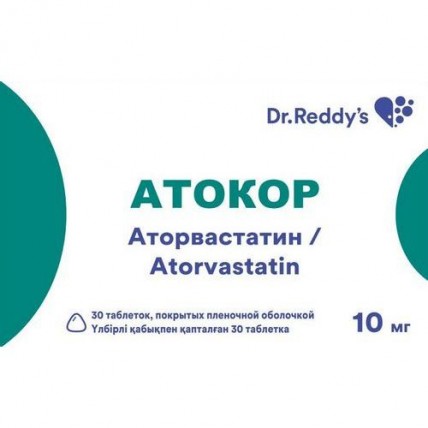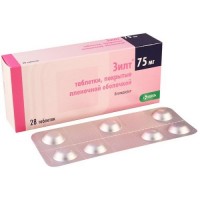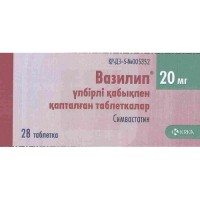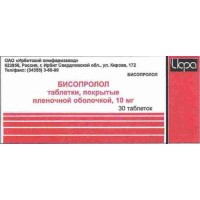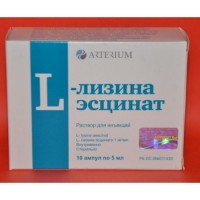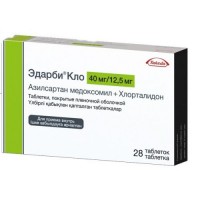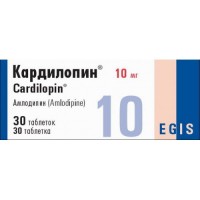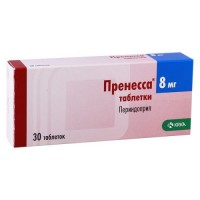Atokor 30s 10 mg film-coated tablets
- $12.10
The instruction for medical use of ATOKOP medicine the Trade name Atokor Mezhdunarodnoye the unlicensed name Atorvastatin Lekarstvennaya the Tablet form, film coated 10 mg, 20 mg Structure One tablet contains active agent - calcium of an atorvastatin of trihydrate of 10.84 mg, 21.68 mg (it is equivalent to an atorvastatin of 10.00 mg, 20.00 mg) excipients: cellulose microcrystalline 114, Mannitolum, sodium of starch glikolit (type A), hydroxypropyl cellulose (Klutsel - LF), half-oxameasures 40, Megluminum, magnesium stearate, cellulose microcrystalline the 102nd structure of a cover: Opadray white 03H18479 (a gipromelloza of 6 joint ventures, the propylene glycol, talc purified the titan E 171 dioxide) the Description of the Tablet, film coated from white till almost white color of triangular shape, with a biconvex surface with inscription A on one party and 10 on other party, thickness (3.20 ± 0.30) mm and height of a triangle (7.00 ± 0.20) mm (for a dosage of 10 mg). Tablets, film coated from white till almost white color of triangular shape, with a biconvex surface with inscription A on one party and 20 on other party, thickness (4.20 ± 0.30) mm and height of a triangle (8.50 ± 0.20) mm (for a dosage of 20 mg). Pharmacotherapeutic group Hypolipidemic drugs. Gipokholesterinemichesky and gipotriglitseridemichesky drugs. KoA-reductase GMG inhibitors. Atorvastatin. The ATX C10AA 05 code the Pharmacological Atorvastatin Pharmacokinetics Absorption properties is quickly soaked up after intake, concentration it in blood plasma reaches a maximum in 1-2 hours. Extent of absorption and concentration of an atorvastatin in blood plasma raise in proportion to a dose. The absolute bioavailability of an atorvastatin is about 14%, and system bioavailability of the inhibiting activity concerning GMG-KoA-reduktazy - about 30%. The low system bioavailability is caused by presistemny metabolism in a mucous membrane of digestive tract and/or at 'the first passing' through a liver. Food reduces the speed and extent of absorption of drug a little (by 25% and 9%, respectively, what results of definition of Cmax and AUC testify to), however decrease in cholesterol of lipoproteids of the low density (HS-LPNP) is similar to that at reception of an atorvastatin on an empty stomach. After reception of an atorvastatin in the evening its concentration in blood plasma is lower (Cmax and AUC approximately for 30%), than after reception in the morning. Nevertheless, decrease in the HS-LPNP levels is similar, irrespective of time of day of administration of drug. Distribution the Average volume of distribution of an atorvastatin makes about 381 l. Communication with proteins of blood plasma not less than 98%. The relation of maintenance of an atorvastatin in erythrocytes/plasma makes about 0.25, i.e. atorvastatin badly gets into erythrocytes. Metabolism Atorvastatin is substantially metabolized with education orto- and para-hydroxylated derivatives and various products of beta oxidation. Orto- and para-hydroxylated metabolites have inhibiting effect on GMG-KoA-reduktazu. About 70% of decrease of the activity of GMG-KoA-reduktazy happen due to action of the active circulating metabolites. In metabolism of an atorvastatin liver P450 3A4 cytochrome plays an important role: concentration of an atorvastatin in blood plasma of the person at a concomitant use of erythromycin which is inhibitor of this isoenzyme increases. Removal Atorvastatin and his metabolites are removed, mainly, with bile as a result of hepatic and/or extrahepatic metabolism (atorvastatin is not exposed to the significant enterohepatic recirculation). Elimination half-life of an atorvastatin makes about 14 h. The inhibiting activity concerning GMG-KoA-reduktazy remains about 20-30 h, thanks to existence of active metabolites. Less than 2% of the accepted dose of an atorvastatin are removed with urine. Special groups of patients Patients of advanced age of Concentration of an atorvastatin in blood plasma at patients at the age of 65 years are also more senior above (Cmax approximately for 40%, AUC approximately for 30%), than at adult patients of young age. Clinical data confirm higher extent of decrease in the LDL level at any dose of drug in population of elderly patients in comparison with younger adult patients. Patients of children's age Data on pharmacokinetics in population of patients of children's age are absent. Paul Koncentration of an atorvastatin in blood plasma at women differs (Cmax is about 20% higher, and AUC 10% lower) from that at men, however clinically significant distinctions of influence of drug on lipidic exchange at men and women are not revealed. A renal failure of the Disease of kidneys do not affect concentration of an atorvastatin in blood plasma or its impact on indicators of lipidic exchange, in this regard change of a dose with a renal failure is not required from patients. A hemodialysis In spite of the fact that researches with participation of patients with an end-stage of a disease of kidneys were not conducted, it is improbable that the hemodialysis will lead to significant increase in clearance of an atorvastatin as drug is substantially connected with proteins of blood plasma. The abnormal liver function At patients with alcoholic cirrhosis concentration of an atorvastatin considerably raises. At patients with class A diseases on classification Chayld - I Drink indicators of Cmax and AUC are raised by 4 times. At patients with class B diseases on classification Chayld - I Drink indicators of Cmax and AUC are raised approximately in 16 and 11 times respectively. Influence of the drugs taken at the same time on pharmacokinetics of an atorvastatin the drug Taken at the same time and the mode of dosing Atorvastatin Doza (mg) Change of AUC1 Change of Cmax1 Cyclosporine in a dose of 5.2 mg/kg/days, a stable dose of 10 mg of 1 ruble/days within 28 days ↑ 8.7 times ↑ 10.7 times Tipranavir in a dose of 500 mg of 2 rubles/days / ritonavir in a dose of 200 mg of 2 rubles/days, 7 days of 10 mg, ODES ↑ 9.4 times ↑ 8.6 times Telaprevir in a dose of 750 mg of 1 river of/8 hours, 10 days of 20 mg, ODES ↑ 7.88 times ↑ 10.6 times 3sakvinavir in a dose of 400 mg of 2 rubles/days / ritonavir in a dose of 400 mg of 2 rubles/days, 15 days of 40 mg of 1 ruble/days within 4 days ↑ 3.9 times ↑ 4.3 times Klaritromitsin in a dose of 500 mg of 2 rubles/days, 9 days of 80 mg of 1 ruble/days within 8 days ↑ 4.4 times ↑ 5.4 times Darunavir in a dose of 300 mg of 2 rubles/days / ritonavir in a dose of 100 mg of 2 rubles/days, 9 days of 10 mg of 1 ruble/days within 4 days ↑ 3.4 times ↑ 2.25 times Itrakonazol in a dose of 200 mg of 1 ruble/days, 4 days of 40 mg, ODES ↑ 3.3 times ↑ 20% Fosamprenavir in a dose of 700 mg of 2 rubles/days / ritonavir in a dose of 100 mg of 2 rubles/days, 14 days of 10 mg of 1 ruble/days within 4 days ↑ 2.53 times ↑ 2.84 times Fosamprenavir in a dose of 1400 mg of 2 rubles/days, 14 days of 10 mg of 1 ruble/days within 4 days ↑ 2.3 times ↑ 4.04 times Nelfinavir in a dose of 1250 mg of 2 rubles/days, 14 days of 10 mg of 1 ruble/days within 28 days ↑ 74% ↑ 2.2 times Grapefruit juice, 240 ml of 1 ruble/days * 40 mg, ODES ↑ 37% ↑ 16% Diltiazem in a dose of 240 mg of 1 ruble/days, 28 days of 40 mg, ODES ↑ 51% Without changes Erythromycin in a dose of 500 mg of 4 rubles/days, 7 days of 10 mg, ODES ↑ 33% ↑ 8% Amlodipin in a dose of 10 mg, a single dose of 80 mg, ODES ↑ 15% ↑ 12% Cimetidinum in a dose of 300 mg of 4 rubles/days, 2 weeks of 10 mg of 1 ruble/days within 2 weeks Less than 1% ↓ 11% Kolestipol in a dose of 10 mg of 2 rubles/days, 28 weeks of 40 mg of 1 ruble/days within 28 weeks was not defined ↓ 26% ** by Maaloks of TC® in a dose of 30 ml of 1 ruble/days, 17 days of 10 mg of 1 ruble/days within 15 days ↓ 33% ↓ 34% Efavirenz in a dose of 600 mg of 1 ruble/days, 14 days of 10 mg within 3 days ↓ 41% ↓ 1% Rifampinum in a dose of 600 mg of 1 ruble/days, 7 days (accepted at the same time) 2 40 mg, ODES ↑ 30% ↑ 2.7 times Rifampinum in a dose of 600 mg of 1 ruble/days, 5 days (in separate doses) 2 40 mg, ODES ↓ 80% ↓ 40% Gemfibrozil in a dose of 600 mg of 2 rubles/days, 7 days of 40 mg of ODES ↑ 35% Less than 1% Fenofibrat in a dose of 160 mg of 1 ruble/days, 7 days of 40 mg of ODES ↑ 3% ↑ 2% Botseprevir in a dose of 800 mg of 3 rubles/days., 7 days of 40 mg, ODES ↑ 2.30 times ↑ 2.66 times 1 Data which are provided in a type of frequency rate of change represent a simple ratio between simultaneous use of drugs and an atorvastatina in the form of monotherapy (i.e. by 1 time - without changes). Data which are provided in a type of % of change present themselves a percentage difference concerning an atorvastatin in the form of monotherapy (i.e. 0% - changes are absent). * More significant increase by AUC (to 2.5-fold) and/or was observed by Cmax (up to 71%) at excess consumption of grapefruit juice (≥ 750 ml - 1.2 l a day). ** One sample taken in 8-16 hours after introduction of a dose. 2 Due to the double mechanism of interaction from Rifampinum the simultaneous use of an atorvastatin with Rifampinum as use of an atorvastatin after Rifampinum was followed after a while by significant decrease in concentration of an atorvastatin in blood plasma is recommended. 3 Dose of a sakvinavir with ritonaviry, used in this research, are not applied in clinical practice. When using in clinical doses the increase in level of influence of an atorvastatin will probably be more essential, than observed in this research. Therefore it is necessary to use drug with care and to use the lowest necessary dose. Influence of an atorvastatin on pharmacokinetics of the Atorvastatin Prinimayemy medicines taken at the same time at the same time the drug and the mode of dosing the Drug/dose (mg) Change of AUC Change of Cmax of 80 mg of 1 ruble/days within 15 days Antipyrine in a dose of 600 mg, ODES ↑ 3% ↓ 11% 80 mg of 1 ruble/days within 14 days Digoxin in a dose of 0.25 mg of 1 ruble/days, 20 days ↑ 15% ↑ 20% 40 mg of 1 ruble/days within 22 days the Oral contraceptive, 1 ruble/days, 2 months - norethindrone of 1 mg - ethinylestradiol of 35 mkg ↑ 28% ↑ 19% ↑ 23% ↑ 30% 10 mg, ODES Tipranavir in a dose of 500 mg of 2 rubles/days / ritonavir in a dose of 200 mg of 2 rubles/days, 7 days Without changes Without changes of 10 mg of 1 ruble/days within 4 days Fosamprenavir in a dose of 1400 mg of 2 rubles/days, 14 days ↓ 27% ↓ 18% 10 mg of 1 ruble/days within 4 days Fosamprenavir in a dose of 700 mg of 2 rubles/days / ritonavir in a dose of 100 mg of 2 rubles/days, 14 days Without changes Without changes the Pharmacodynamics of Atokor® – a selection competitive inhibitor of GMG-KoA-reduktazy - the enzyme turning 3-hydroksi-3-metilglutaril-KoA into mevalonovy acid - the predecessor of steroids, including cholesterol. At patients with a homozygous and heterozygous family hypercholesterolemia, single forms of a hypercholesterolemia and the mixed dislipidemiya Atokor reduces the content in blood plasma of the general cholesterol (XC), cholesterol of lipoproteids of low density and apolipoprotein B and also cholesterol of lipoproteids of very low density (HS-LPONP) and triglycerides, causes unstable increase in content of cholesterol of lipoproteids of the high density (HS-LPVP) and A-1 apolipoprotein. Atokor reduces levels of the general cholesterol, HS-LPNP, HS-LPONP, apolipoprotein B, triglyceryls and ne-HS-LPVP and increases the HS-LPVP levels at patients with the isolated gipertriglitseridemiya. Атокор® suppresses production of cholesterol of lipoproteins of the intermediate density (HS-LPPP) at patients with a disbetalipoproteinemiya. In a liver triglycerides and cholesterol are included lipoproteids of very low density (LPONP), come to blood plasma and are transferred to peripheral fabrics. Lipoproteids of the low density (LDL) which catabolize in interaction with high-affine receptors of LDL are formed of LPONP. Atokor reduces levels of cholesterol and lipoproteins in plasma, inhibiting GMG-KoA-reduktazu and synthesis of cholesterol in a liver and increasing the number of receptors of LDL on a surface of cells of a liver for activization of absorption and catabolism of LDL, Atokor also suppresses production of LDL and reduces quantity of particles of LDL. Atokor reduces the HS-LPNP level at patients with the homozygous hereditary hypercholesterolemia (HH) in population which seldom gives the answer to other medicines reducing levels of lipids. Pharmacological Atokor and some of his metabolites are active. The main scene of action is the liver which is also the main place of synthesis of cholesterol and clearance of LDL. Decrease in the HS-LPNP level is connected rather with a drug dosage, than with system concentration of drug. Individual selection of a dosage of drug has to be based on the therapeutic answer. Indications Atokor is shown: - as addition to a diet for decrease in the increased levels of the general cholesterol, HS-LPNP, apolipoprotein B and triglycerides and increase in the HS-LPVP level at patients with primary hypercholesterolemia (heterozygous hereditary and not hereditary) and the mixed dislipidemiya (the IIa and IIb types on Fredrikson's classification), - for decrease in levels of the general cholesterol and HS-LPNP at patients with a homozygous hereditary hypercholesterolemia as an additional tool to other hypolipidemic therapy (aferez LDL, etc.) or if such therapy is inaccessible. Children's and teenage age the Hypercholesterolemia Use of the drug Atokor for treatment of children has to be carried out only by doctors, the treatments of a lipidemia having experience at children, and patients on a regular basis have to pass repeated assessment for progress definition. Atokor is shown to use for patients with a heterozygous family hypercholesterolemia aged from 10 years and is more senior, with a dose of an atorvastatin of 10 mg a day and can be increased up to 80 mg a day according to reaction of the patient and tolerance of drug. Prevention of cardiovascular diseases - prevention of cardiovascular diseases at the adult patients having high risk of development of cardiovascular events for reduction of risk of lethal outcomes of an ischemic heart disease, development of a myocardial infarction. At patients with the coronary artery disease (CAD) or multiple factors of risk of KBS the use by the drug Atokor can be begun along with a diet. Medicinal therapy is recommended as addition to a diet, as a component of medicinal therapy at multiple factors of risk at persons with significantly the increased risk of an atherosclerotic disease of vessels in connection with a hypercholesterolemia. A repeated stroke Use of an atorvastatin had a stroke or the tranzitorny ischemic attack (TIA) and in which anamnesis were not the coronary heart disease (CHD), use of the drug Atokor in a dose of 80 mg a day. Use restrictions Atokor's Use in case of diseases in which the main disturbance from lipoproteins is increase in levels of chylomicrons (the I and V types on Fredrikson's classification), was not studied. A route of administration and doses the Lipidemia (heterozygous hereditary and not hereditary) and the mixed dislipidemiya (the IIa and IIb types on Fredrikson's classification) the Recommended initial dose of the drug Atokor makes 10 mg once a day. The patients needing considerable decrease in the HS-LPNP level (more than 45%) can begin treatment with a dose of 40 mg once a day. Range of doses of Atokor medicine is from 10 mg to 80 mg once a day. Atokor it is possible to accept in a single dose irrespective of meal at any time. The initial and supporting doses of Atokor medicine are selected in each separate case according to features of patients, such as purpose of therapy and answer. After the beginning of therapy and/or during selection of a dose of the drug Atokor it is necessary to carry out the analysis of levels of lipids within 2–4 weeks and as appropriate to adjust a dose. The homozygous hereditary hypercholesterolemia Atokor's Dose for patients with the homozygous hereditary hypercholesterolemia (HH) an initial dose makes 10, the maximum 80 mg a day. At these patients Atokor it is necessary to use as an additional tool to other hypolipidemic therapy (aferez LDL, etc.) or if such therapy is inaccessible. The accompanying hypolipidemic therapy Atokor it is possible to apply together with sekvestrant of bile acids. The combination of inhibitors of GMG-KoA-reduktazy (statines) and fibrat usually should be applied with care. Patients with a renal failure of the Disease of kidneys do not affect Atokor's concentration in blood plasma or decrease in the HS-LPNP levels therefore dose adjustment with dysfunction of kidneys is not required from patients. The patients accepting cyclosporine, klaritromitsin, itrakonazol or certain inhibitors of protease to the Patients accepting cyclosporine, HIV protease inhibitors (tipranavir with ritonaviry) or hepatitis C virus protease inhibitor (telaprevir), it is not necessary to appoint Atokor. To patients with HIV,
ayushchy lopinavir with ritonaviry, it is necessary to appoint prin Atokor with care and in the lowest necessary dose. At the patients accepting klaritromitsin or itrakonazol and patients from the HIV accepting a combination of a sakvinavir with ritonaviry, a darunavira with ritonaviry, fosamprenavir or fosamprenavir with ritonaviry it is not necessary to exceed Atokor's dose of 20 mg and it is recommended to carry out the corresponding clinical assessment to guarantee use of the lowest necessary dose of Atokor. At the patients accepting HIV protease inhibitor - nelfinavir or hepatitis C virus protease inhibitor - botseprevir, it is not necessary to exceed Atokor's dose of 40 mg and it is recommended to carry out the corresponding clinical assessment to guarantee use of the lowest necessary dose of Atokor. Side effects At use of an atorvastatin are registered undesirable effects which were classified by the frequency of their manifestation as follows: often (from ≥ 1/100 to & lt, 1/10), infrequently (from ≥ 1/1000 to & lt, 1/100) and it is rare (≥ 1/10,000 and & lt, 1/1000), is very rare (from ≤1/10000) and it is unknown (it is impossible to determine by the available data). Often - a headache - a nasopharyngitis - a hyperglycemia - throat and throat pain, nasal bleeding - dyspepsia, nausea, a constipation, a meteorism, diarrhea - an arthralgia, extremity pain, myotonia, myalgia, swelling of joints, a dorsodynia - an aberration of biochemical indicators of function of a liver, the increased creatine kinase level in blood - allergic reactions Infrequently - a hypoglycemia, increase in body weight, anorexia - dreadful dreams, insomnia - dizziness, paresthesia, a hypesthesia, a dysgeusia, amnesia - the obscured sight - sonitus - vomiting, pain in the upper and lower part of a stomach, an eructation, pancreatitis - hepatitis - urticaria, skin rash, an itching, an alopecia - neck pain, muscular fatigue - an indisposition, an asthenia, thorax pain, peripheral hypostasis, increased fatigue, a pyrexia - emergence of leukocytes in urine Is rare - thrombocytopenia - peripheral neuropathy - a disorder of vision - a cholestasia - a Quincke's disease, bullous dermatitis, including a polymorphic erythema, Stephens's syndrome - Johnson and a toxic epidermal necrolysis - a myopathy, a miositis, a rhabdomyolysis, a tendinopatiya sometimes complicated by a gap Very seldom - an anaphylaxis - a hearing loss - a liver failure with lethal and non-lethal outcomes - a gynecomastia - forgetfulness, memory loss, amnesia, confusion of consciousness It is unknown - the immunomediated necrotizing myopathy the Following side effects were revealed at patients of children's age: Often - a headache - an abdominal pain - increase in levels of alaninaminotranspherase and a serumal kreatinfosfokinaza (KFK) Now available information on safety at long therapy at patients of children's age is limited. Concerning some statines it was reported about the following undesirable phenomena: - sexual dysfunction - a depression - exclusively exceptional cases of an interstitial pulmonary disease, especially at long-term therapy - diabetes: frequency will depend on existence or lack of risk factors (glucose in blood on an empty stomach ≥ 5.6 mmol/l, BMI & gt, 30 kg/sq.m, the increased levels of triglycerides, arterial hypertension in the anamnesis) the Message of data on expected undesirable reactions the Message of data on the expected undesirable reactions revealed after medicine registration is of great importance. It allows to continue monitoring of a ratio of advantage and risk of medicine. Health workers and patients are asked to report about any undesirable reactions to the address specified at the end of this instruction for medical use. Contraindications - hypersensitivity to any of drug components - an active disease of a liver, including increase in activity of transaminases of serum of not clear genesis - pregnancy and the period of a lactation and also at the women of reproductive age who are not using adequate methods of contraception - a hereditary lactose intolerance, deficiency of Lappa lactase, glucose galactose malabsorption - children's and teenage age up to 10 years Medicinal interactions Risk of development of a myopathy during treatment by statines increases at simultaneous use of derivatives of fibroyevy acid, Niacinum in the doses modifying levels of lipids, cyclosporine or strong CYP inhibitors 3A4 (for example, a klaritromitsina, inhibitors of HIV protease and an itrakonazol). Strong CYP3A4 inhibitors Atorvastatin is metabolized by P450 3A4 cytochrome. The concomitant use of an atorvastatin with strong CYP3A4 inhibitors can lead to increase in concentration of an atorvastatin in blood plasma. Extent of interaction and strengthening of effects depends on variability of influence on CYP3A4. Klaritromitsin the AUC Value of an atorvastatin significantly increased at a concomitant use of an atorvastatin in a dose of 80 mg with klaritromitsiny (500 mg two times a day) in comparison with monotherapy atorvastatiny. Therefore, at the patients accepting klaritromitsin atorvastatin it is necessary to apply with care if its dose exceeds 20 mg. A combination of inhibitors of protease the AUC Value of an atorvastatin significantly increased at a concomitant use of the drug Atokor with several combinations of inhibitors of HIV protease and also with hepatitis C virus protease inhibitor - telapreviry in comparison with monotherapy atorvastatiny. Therefore, to the patients accepting HIV protease inhibitors - tipranavir with ritonaviry or hepatitis C virus protease inhibitor - telaprevir, it is not necessary to appoint them along with atorvastatiny. To the patients accepting HIV protease inhibitors - lopinavir with ritonaviry, it is necessary to appoint Atokor with care and to choose the lowest necessary dose. At the patients accepting HIV protease inhibitors - sakvinavir with ritonaviry, darunavir with ritonaviry, fosamprenavir or fosamprenavir with ritonaviry, the dose of an atorvastatin should not exceed 20 mg and this drug should be used with care. At the patients accepting HIV protease inhibitor - nelfinavir or hepatitis C virus protease inhibitor - botseprevir, it is not necessary to exceed a dose of an atorvastatin of 40 mg and it is recommended to conduct careful clinical monitoring. Itrakonazol the AUC Value of an atorvastatin significantly increased at a concomitant use of the drug Atokor in a dose of 40 mg with itrakonazoly in a dose of 200 mg. Therefore, at the patients accepting itrakonazol Atokor it is necessary to apply with care if his dose exceeds 20 mg. Grapefruit juice Contains one or several components which inhibit CYP3A4 cytochrome and can increase concentration of an atorvastatin in blood plasma, especially at overconsumption of grapefruit juice (& gt, 1.2 liters a day). Atorvastatin cyclosporine and its metabolites are OATP1B1 conveyor substrates. OATP1B1 conveyor inhibitors (for example, cyclosporine) can increase bioavailability of an atorvastatin. The AUC value of an atorvastatin significantly increased at a concomitant use of the drug Atokor in a dose of 10 mg with cyclosporine in a dose of 5.2 mg/kg/days in comparison with monotherapy by the drug Atokar. Gemfibrozil Due to the increased risk of a myopathy/rhabdomyolysis at a concomitant use of inhibitors of GMG-KoA-reduktazy with gemfibrozily it is necessary to avoid a concomitant use of an atorvastatin with gemfibrozily. Other fibrata As it is known that at treatment by GMG-KoA-reduktazy inhibitors the risk of a myopathy increases in case of a concomitant use of other fibrat, atorvastattin along with other fibrata it is necessary to apply with care. Niacinum in case of use of an atorvastatin in a combination with Niacinum can raise risk of influence on skeletal muscles, in this case it is necessary to consider the possibility of a dose decline of an atorvastatin. Rifampinum and other inductors of P450 3A4 cytochrome can lead Simultaneous use of an atorvastatin with inductors of P450 3A4 cytochrome (for example, efavirenzy, Rifampinum) to the decrease in concentration of an atorvastatin in blood plasma expressed in various degree. Due to the double mechanism of interaction from Rifampinum the simultaneous use of an atorvastatin with Rifampinum as use of an atorvastatin after Rifampinum was followed after a while by significant decrease in concentration of an atorvastatin in blood plasma is recommended. Digoxin At simultaneous use of repeated doses of an atorvastatin and digoxin the equilibrium concentration of digoxin in blood plasma increased approximately by 20%. The patients accepting digoxin have to be under careful observation. Oral contraceptives Simultaneous use of an atorvastatin with oral contraceptives increased AUC values for norethindrone and ethinylestradiol This increase should be considered when choosing an oral contraceptive for the women accepting atorvastatin. Warfarin At reception by the patients undergoing long-term treatment by warfarin atorvastatin had no clinically significant impact on a prothrombin time. Colchicine It was reported about myopathy cases, including a rhabdomyolysis, at simultaneous use of an atorvastatin and colchicine therefore it is necessary to appoint with care atorvastatin along with colchicine. Special instructions Skeletal muscles It was reported about exceptional cases of a rhabdomyolysis with the acute renal failure caused by a myoglobinuria at reception of an atorvastatin and other drugs of this class. Existence at patients can serve in the anamnesis of a renal failure as risk factor of developing a rhabdomyolysis. At such patients it is necessary to carry out more careful monitoring of influence of drug on skeletal muscles. Atorvastatin, as well as other statines, sometimes causes the myopathy defined as muscle pain or muscle weakness, accompanied with increase in levels of a kreatinfosfokinaza (KFK) & gt, 10 times are higher than VGN. At reception of an atorvastatin in high doses along with some other drugs, such as cyclosporine and strong CYP3A4 inhibitors (for example, klaritromitsin, itrakonazol and HIV protease inhibitors), the risk of a myopathy/rhabdomyolysis increases. Rare messages about cases of the immunomediated necrotizing myopathy (IONM), an autoimmune myopathy, in connection with use of statines arrived. IONM is characterized by proximal muscle weakness and the increased creatine kinase level in blood serum which remain despite treatment cancellation by statines, the results of a biopsy of muscles showing a necrotizing myopathy without significant inflammation, improvement of a state at use of immunodepressants. It is necessary to consider a possibility of development of a myopathy in any patient with diffusion myalgias, morbidity or weakness of muscles and/or significant increase in the KFK level. It is necessary to recommend to patients to report immediately about arisen for the obscure cause of muscular pain, morbidity or weakness, especially if they are followed by an indisposition or fever or if muscular manifestations and symptoms remain after cancellation of an atorvastatin. At significant increase in the KFK levels, diagnosing of a myopathy or suspicion on a myopathy it is necessary to stop therapy atorvastatiny. The risk of a myopathy during therapy by drugs of this class increases at simultaneous use of cyclosporine, derivatives of fibroyevy acid, erythromycin, a klaritromitsin, hepatitis C virus protease inhibitor - a telaprevira, combinations of inhibitors of HIV protease, including sakvinavir with ritonaviry, lopinavir with ritonaviry, tipranavir with ritonaviry, darunavir with ritonaviry, fosamprenavir and fosamprenavir with ritonaviry and also Niacinum or azolny antifungal drugs. Doctors who consider the possibility of combination therapy by Atokorom® and derivatives of fibroyevy acid, erythromycin, klaritromitsiny, a combination of a sakvinavir with ritonaviry, a lopinavir with ritonaviry, a darunavir with ritonaviry, fosamprenaviry or fosamprenaviry with ri
to Develop
ayushchy lopinavir with ritonaviry, it is necessary to appoint prin Atokor with care and in the lowest necessary dose. At the patients accepting klaritromitsin or itrakonazol and patients from the HIV accepting a combination of a sakvinavir with ritonaviry, a darunavira with ritonaviry, fosamprenavir or fosamprenavir with ritonaviry it is not necessary to exceed Atokor's dose of 20 mg and it is recommended to carry out the corresponding clinical assessment to guarantee use of the lowest necessary dose of Atokor. At the patients accepting HIV protease inhibitor - nelfinavir or hepatitis C virus protease inhibitor - botseprevir, it is not necessary to exceed Atokor's dose of 40 mg and it is recommended to carry out the corresponding clinical assessment to guarantee use of the lowest necessary dose of Atokor. Side effects At use of an atorvastatin are registered undesirable effects which were classified by the frequency of their manifestation as follows: often (from ≥ 1/100 to & lt, 1/10), infrequently (from ≥ 1/1000 to & lt, 1/100) and it is rare (≥ 1/10,000 and & lt, 1/1000), is very rare (from ≤1/10000) and it is unknown (it is impossible to determine by the available data). Often - a headache - a nasopharyngitis - a hyperglycemia - throat and throat pain, nasal bleeding - dyspepsia, nausea, a constipation, a meteorism, diarrhea - an arthralgia, extremity pain, myotonia, myalgia, swelling of joints, a dorsodynia - an aberration of biochemical indicators of function of a liver, the increased creatine kinase level in blood - allergic reactions Infrequently - a hypoglycemia, increase in body weight, anorexia - dreadful dreams, insomnia - dizziness, paresthesia, a hypesthesia, a dysgeusia, amnesia - the obscured sight - sonitus - vomiting, pain in the upper and lower part of a stomach, an eructation, pancreatitis - hepatitis - urticaria, skin rash, an itching, an alopecia - neck pain, muscular fatigue - an indisposition, an asthenia, thorax pain, peripheral hypostasis, increased fatigue, a pyrexia - emergence of leukocytes in urine Is rare - thrombocytopenia - peripheral neuropathy - a disorder of vision - a cholestasia - a Quincke's disease, bullous dermatitis, including a polymorphic erythema, Stephens's syndrome - Johnson and a toxic epidermal necrolysis - a myopathy, a miositis, a rhabdomyolysis, a tendinopatiya sometimes complicated by a gap Very seldom - an anaphylaxis - a hearing loss - a liver failure with lethal and non-lethal outcomes - a gynecomastia - forgetfulness, memory loss, amnesia, confusion of consciousness It is unknown - the immunomediated necrotizing myopathy the Following side effects were revealed at patients of children's age: Often - a headache - an abdominal pain - increase in levels of alaninaminotranspherase and a serumal kreatinfosfokinaza (KFK) Now available information on safety at long therapy at patients of children's age is limited. Concerning some statines it was reported about the following undesirable phenomena: - sexual dysfunction - a depression - exclusively exceptional cases of an interstitial pulmonary disease, especially at long-term therapy - diabetes: frequency will depend on existence or lack of risk factors (glucose in blood on an empty stomach ≥ 5.6 mmol/l, BMI & gt, 30 kg/sq.m, the increased levels of triglycerides, arterial hypertension in the anamnesis) the Message of data on expected undesirable reactions the Message of data on the expected undesirable reactions revealed after medicine registration is of great importance. It allows to continue monitoring of a ratio of advantage and risk of medicine. Health workers and patients are asked to report about any undesirable reactions to the address specified at the end of this instruction for medical use. Contraindications - hypersensitivity to any of drug components - an active disease of a liver, including increase in activity of transaminases of serum of not clear genesis - pregnancy and the period of a lactation and also at the women of reproductive age who are not using adequate methods of contraception - a hereditary lactose intolerance, deficiency of Lappa lactase, glucose galactose malabsorption - children's and teenage age up to 10 years Medicinal interactions Risk of development of a myopathy during treatment by statines increases at simultaneous use of derivatives of fibroyevy acid, Niacinum in the doses modifying levels of lipids, cyclosporine or strong CYP inhibitors 3A4 (for example, a klaritromitsina, inhibitors of HIV protease and an itrakonazol). Strong CYP3A4 inhibitors Atorvastatin is metabolized by P450 3A4 cytochrome. The concomitant use of an atorvastatin with strong CYP3A4 inhibitors can lead to increase in concentration of an atorvastatin in blood plasma. Extent of interaction and strengthening of effects depends on variability of influence on CYP3A4. Klaritromitsin the AUC Value of an atorvastatin significantly increased at a concomitant use of an atorvastatin in a dose of 80 mg with klaritromitsiny (500 mg two times a day) in comparison with monotherapy atorvastatiny. Therefore, at the patients accepting klaritromitsin atorvastatin it is necessary to apply with care if its dose exceeds 20 mg. A combination of inhibitors of protease the AUC Value of an atorvastatin significantly increased at a concomitant use of the drug Atokor with several combinations of inhibitors of HIV protease and also with hepatitis C virus protease inhibitor - telapreviry in comparison with monotherapy atorvastatiny. Therefore, to the patients accepting HIV protease inhibitors - tipranavir with ritonaviry or hepatitis C virus protease inhibitor - telaprevir, it is not necessary to appoint them along with atorvastatiny. To the patients accepting HIV protease inhibitors - lopinavir with ritonaviry, it is necessary to appoint Atokor with care and to choose the lowest necessary dose. At the patients accepting HIV protease inhibitors - sakvinavir with ritonaviry, darunavir with ritonaviry, fosamprenavir or fosamprenavir with ritonaviry, the dose of an atorvastatin should not exceed 20 mg and this drug should be used with care. At the patients accepting HIV protease inhibitor - nelfinavir or hepatitis C virus protease inhibitor - botseprevir, it is not necessary to exceed a dose of an atorvastatin of 40 mg and it is recommended to conduct careful clinical monitoring. Itrakonazol the AUC Value of an atorvastatin significantly increased at a concomitant use of the drug Atokor in a dose of 40 mg with itrakonazoly in a dose of 200 mg. Therefore, at the patients accepting itrakonazol Atokor it is necessary to apply with care if his dose exceeds 20 mg. Grapefruit juice Contains one or several components which inhibit CYP3A4 cytochrome and can increase concentration of an atorvastatin in blood plasma, especially at overconsumption of grapefruit juice (& gt, 1.2 liters a day). Atorvastatin cyclosporine and its metabolites are OATP1B1 conveyor substrates. OATP1B1 conveyor inhibitors (for example, cyclosporine) can increase bioavailability of an atorvastatin. The AUC value of an atorvastatin significantly increased at a concomitant use of the drug Atokor in a dose of 10 mg with cyclosporine in a dose of 5.2 mg/kg/days in comparison with monotherapy by the drug Atokar. Gemfibrozil Due to the increased risk of a myopathy/rhabdomyolysis at a concomitant use of inhibitors of GMG-KoA-reduktazy with gemfibrozily it is necessary to avoid a concomitant use of an atorvastatin with gemfibrozily. Other fibrata As it is known that at treatment by GMG-KoA-reduktazy inhibitors the risk of a myopathy increases in case of a concomitant use of other fibrat, atorvastattin along with other fibrata it is necessary to apply with care. Niacinum in case of use of an atorvastatin in a combination with Niacinum can raise risk of influence on skeletal muscles, in this case it is necessary to consider the possibility of a dose decline of an atorvastatin. Rifampinum and other inductors of P450 3A4 cytochrome can lead Simultaneous use of an atorvastatin with inductors of P450 3A4 cytochrome (for example, efavirenzy, Rifampinum) to the decrease in concentration of an atorvastatin in blood plasma expressed in various degree. Due to the double mechanism of interaction from Rifampinum the simultaneous use of an atorvastatin with Rifampinum as use of an atorvastatin after Rifampinum was followed after a while by significant decrease in concentration of an atorvastatin in blood plasma is recommended. Digoxin At simultaneous use of repeated doses of an atorvastatin and digoxin the equilibrium concentration of digoxin in blood plasma increased approximately by 20%. The patients accepting digoxin have to be under careful observation. Oral contraceptives Simultaneous use of an atorvastatin with oral contraceptives increased AUC values for norethindrone and ethinylestradiol This increase should be considered when choosing an oral contraceptive for the women accepting atorvastatin. Warfarin At reception by the patients undergoing long-term treatment by warfarin atorvastatin had no clinically significant impact on a prothrombin time. Colchicine It was reported about myopathy cases, including a rhabdomyolysis, at simultaneous use of an atorvastatin and colchicine therefore it is necessary to appoint with care atorvastatin along with colchicine. Special instructions Skeletal muscles It was reported about exceptional cases of a rhabdomyolysis with the acute renal failure caused by a myoglobinuria at reception of an atorvastatin and other drugs of this class. Existence at patients can serve in the anamnesis of a renal failure as risk factor of developing a rhabdomyolysis. At such patients it is necessary to carry out more careful monitoring of influence of drug on skeletal muscles. Atorvastatin, as well as other statines, sometimes causes the myopathy defined as muscle pain or muscle weakness, accompanied with increase in levels of a kreatinfosfokinaza (KFK) & gt, 10 times are higher than VGN. At reception of an atorvastatin in high doses along with some other drugs, such as cyclosporine and strong CYP3A4 inhibitors (for example, klaritromitsin, itrakonazol and HIV protease inhibitors), the risk of a myopathy/rhabdomyolysis increases. Rare messages about cases of the immunomediated necrotizing myopathy (IONM), an autoimmune myopathy, in connection with use of statines arrived. IONM is characterized by proximal muscle weakness and the increased creatine kinase level in blood serum which remain despite treatment cancellation by statines, the results of a biopsy of muscles showing a necrotizing myopathy without significant inflammation, improvement of a state at use of immunodepressants. It is necessary to consider a possibility of development of a myopathy in any patient with diffusion myalgias, morbidity or weakness of muscles and/or significant increase in the KFK level. It is necessary to recommend to patients to report immediately about arisen for the obscure cause of muscular pain, morbidity or weakness, especially if they are followed by an indisposition or fever or if muscular manifestations and symptoms remain after cancellation of an atorvastatin. At significant increase in the KFK levels, diagnosing of a myopathy or suspicion on a myopathy it is necessary to stop therapy atorvastatiny. The risk of a myopathy during therapy by drugs of this class increases at simultaneous use of cyclosporine, derivatives of fibroyevy acid, erythromycin, a klaritromitsin, hepatitis C virus protease inhibitor - a telaprevira, combinations of inhibitors of HIV protease, including sakvinavir with ritonaviry, lopinavir with ritonaviry, tipranavir with ritonaviry, darunavir with ritonaviry, fosamprenavir and fosamprenavir with ritonaviry and also Niacinum or azolny antifungal drugs. Doctors who consider the possibility of combination therapy by Atokorom® and derivatives of fibroyevy acid, erythromycin, klaritromitsiny, a combination of a sakvinavir with ritonaviry, a lopinavir with ritonaviry, a darunavir with ritonaviry, fosamprenaviry or fosamprenaviry with ri
to Develop
